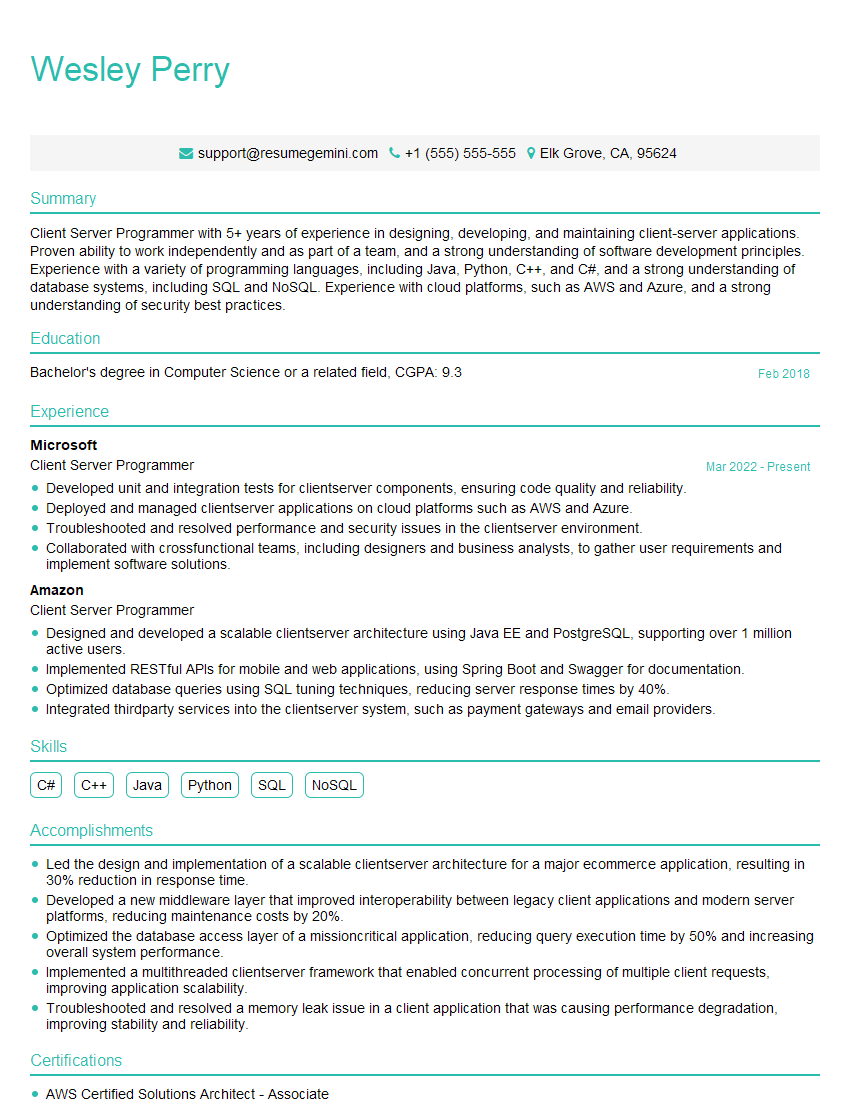Are you a seasoned Client Server Programmer seeking a new career path? Discover our professionally built Client Server Programmer Resume Template. This time-saving tool provides a solid foundation for your job search. Simply click “Edit Resume” to customize it with your unique experiences and achievements. Customize fonts and colors to match your personal style and increase your chances of landing your dream job. Explore more Resume Templates for additional options.

Wesley Perry
Client Server Programmer
Summary
Client Server Programmer with 5+ years of experience in designing, developing, and maintaining client-server applications. Proven ability to work independently and as part of a team, and a strong understanding of software development principles. Experience with a variety of programming languages, including Java, Python, C++, and C#, and a strong understanding of database systems, including SQL and NoSQL. Experience with cloud platforms, such as AWS and Azure, and a strong understanding of security best practices.
Education
Bachelor’s degree in Computer Science or a related field
February 2018
Skills
- C#
- C++
- Java
- Python
- SQL
- NoSQL
Work Experience
Client Server Programmer
- Developed unit and integration tests for clientserver components, ensuring code quality and reliability.
- Deployed and managed clientserver applications on cloud platforms such as AWS and Azure.
- Troubleshooted and resolved performance and security issues in the clientserver environment.
- Collaborated with crossfunctional teams, including designers and business analysts, to gather user requirements and implement software solutions.
Client Server Programmer
- Designed and developed a scalable clientserver architecture using Java EE and PostgreSQL, supporting over 1 million active users.
- Implemented RESTful APIs for mobile and web applications, using Spring Boot and Swagger for documentation.
- Optimized database queries using SQL tuning techniques, reducing server response times by 40%.
- Integrated thirdparty services into the clientserver system, such as payment gateways and email providers.
Accomplishments
- Led the design and implementation of a scalable clientserver architecture for a major ecommerce application, resulting in 30% reduction in response time.
- Developed a new middleware layer that improved interoperability between legacy client applications and modern server platforms, reducing maintenance costs by 20%.
- Optimized the database access layer of a missioncritical application, reducing query execution time by 50% and increasing overall system performance.
- Implemented a multithreaded clientserver framework that enabled concurrent processing of multiple client requests, improving application scalability.
- Troubleshooted and resolved a memory leak issue in a client application that was causing performance degradation, improving stability and reliability.
Certificates
- AWS Certified Solutions Architect – Associate
- Azure Fundamentals
- GCP Cloud Architect
- Docker Certified Associate
Languages
- English
- French
- German
Career Expert Tips:
- Select the ideal resume template to showcase your professional experience effectively.
- Master the art of resume writing to highlight your unique qualifications and achievements.
- Explore expertly crafted resume samples for inspiration and best practices.
- Build your best resume for free this new year with ResumeGemini. Enjoy exclusive discounts on ATS optimized resume templates.
How To Write Resume For Client Server Programmer
- Tailor your resume to the specific job you are applying for.
- Highlight your skills and experience in designing, developing, and maintaining client-server applications.
- Provide specific examples of your work, and quantify your results whenever possible.
- Proofread your resume carefully before submitting it.
Essential Experience Highlights for a Strong Client Server Programmer Resume
- Design and develop scalable client-server architectures.
- Implement RESTful APIs for mobile and web applications.
- Optimize database queries to improve performance.
- Integrate third-party services into client-server systems.
- Develop unit and integration tests for client-server components.
- Deploy and manage client-server applications on cloud platforms.
- Troubleshoot and resolve performance and security issues.
Frequently Asked Questions (FAQ’s) For Client Server Programmer
What is a client-server architecture?
A client-server architecture is a distributed application design that separates the application into two parts: the client and the server. The client is the part of the application that runs on the user’s computer, and the server is the part of the application that runs on a remote computer.
What are the benefits of using a client-server architecture?
There are many benefits to using a client-server architecture, including improved performance, scalability, security, and reliability.
What are the different types of client-server architectures?
There are two main types of client-server architectures: two-tier and three-tier. In a two-tier architecture, the client and the server are directly connected to each other. In a three-tier architecture, there is an additional layer between the client and the server, called the application server.
What are the skills required to be a client-server programmer?
To be a successful client-server programmer, you need to have a strong understanding of software development principles, programming languages, and database systems. You also need to be able to work independently and as part of a team.
What are the career prospects for client-server programmers?
The career prospects for client-server programmers are excellent. As businesses increasingly rely on software to manage their operations, the demand for skilled client-server programmers is growing.
What are the average salaries for client-server programmers?
The average salary for a client-server programmer is around $100,000 per year.